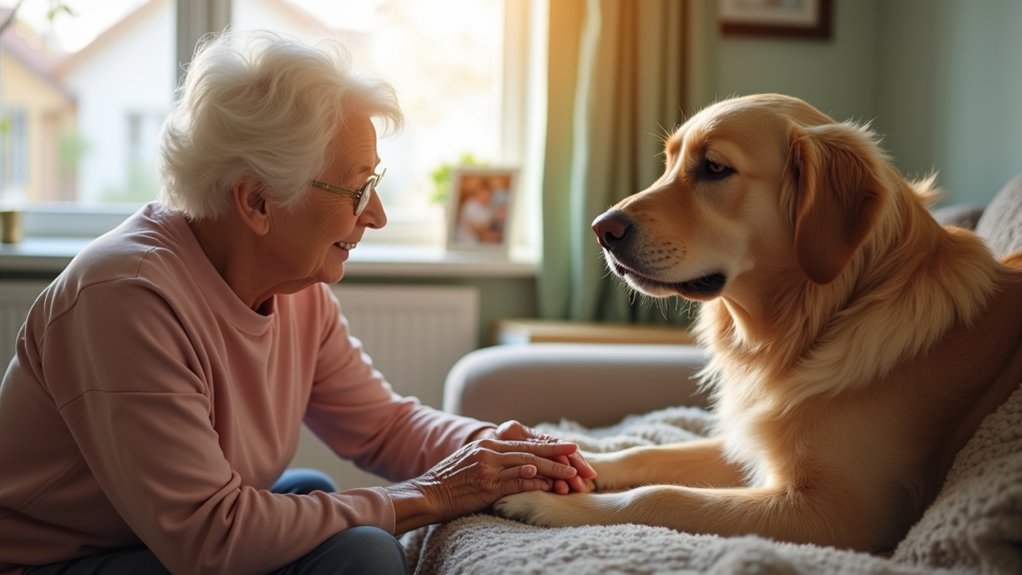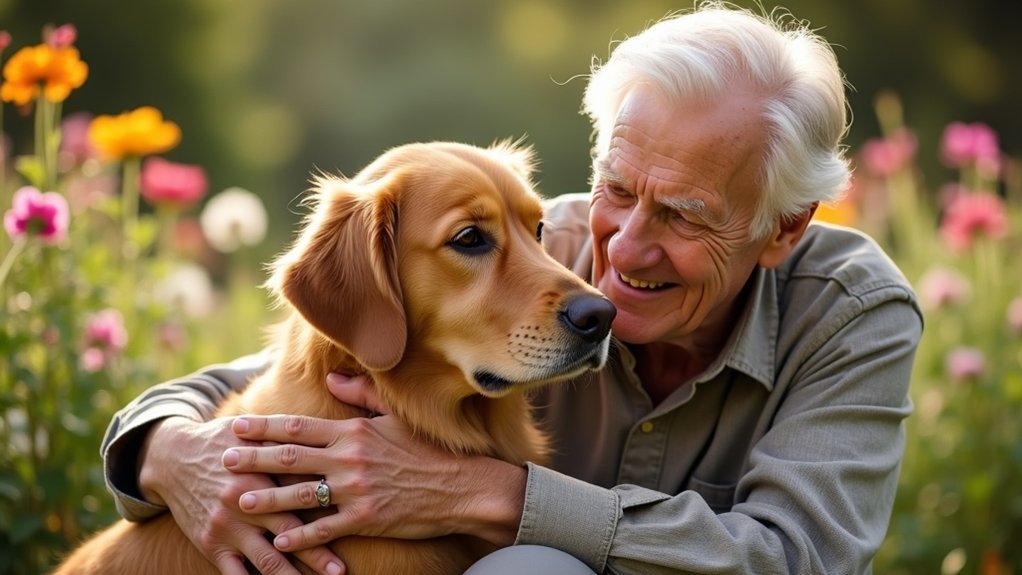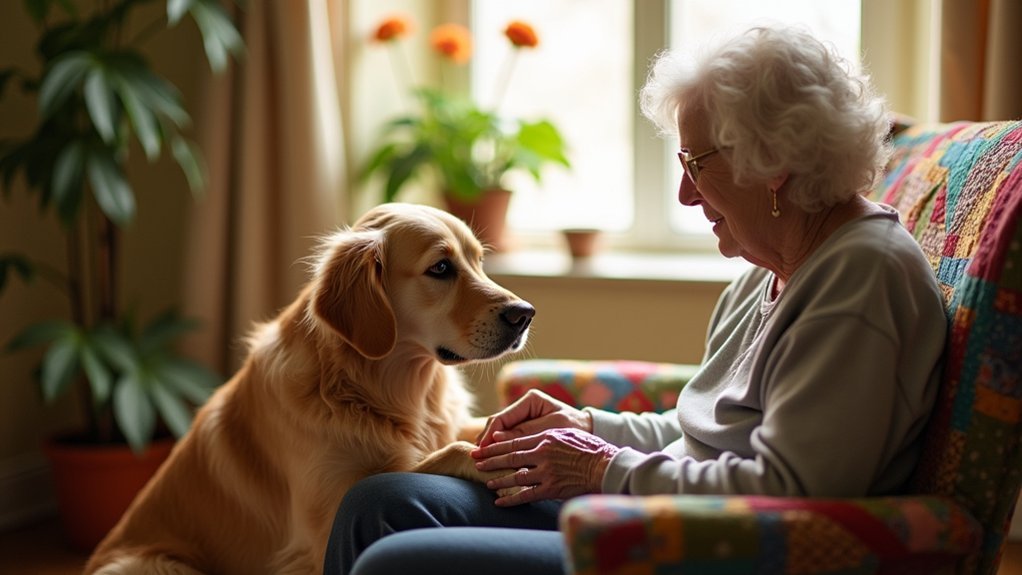Pets boost recovery in Parkinson’s patients by releasing mood-enhancing chemicals like oxytocin, dopamine, and serotonin while reducing stress hormones. They encourage regular physical activity through walking and play, improving mobility and motor control. Your furry companion provides emotional support during symptom fluctuations, reduces isolation, and creates essential daily routines. Service animals can even assist with balance and stability during freezing episodes. The neurological benefits of this special bond extend far beyond simple companionship.
The Science Behind Pet Therapy for Parkinson’s Disease

While researchers are still exploring the full potential of animal companionship in neurological treatment, the science behind pet therapy for Parkinson’s disease reveals promising benefits.
When you interact with pets, your brain releases oxytocin, enhancing your sense of well-being and potentially improving your mood regulation.
This neurological impact extends beyond simple happiness. Pet interactions promote neuroplasticity—your brain’s ability to adapt to changes caused by Parkinson’s. Studies show that regular interactions with pets can significantly reduce feelings of loneliness in patients with chronic conditions like Parkinson’s disease. You’ll experience cognitive stimulation through daily pet care routines, which helps maintain mental function.
The physiological effects are equally significant. Your stress levels decrease during animal interactions, which can directly impact your Parkinson’s symptoms.
These hormonal and neurological changes create a therapeutic environment that complements traditional treatment approaches, potentially reducing your reliance on certain medications.
Movement and Mobility Benefits of Animal Companionship
You’ll find remarkable improvements in your stride patterns when walking with your service dog, as they provide a consistent external rhythm that helps normalize your gait.
Your canine companion can be trained to respond when you experience freezing episodes by nudging or pulling forward, effectively breaking the freeze and allowing you to continue moving.
These mobility solutions work because your dog becomes an extension of your own movement system, creating a partnership that addresses Parkinson’s mobility challenges more effectively than solo efforts.
Service dogs are especially valuable for assisting Parkinson’s patients with daily tasks like retrieving dropped items or medication when mobility is compromised.
Stride Improvement Mechanics
The physiological mechanics behind improved stride in Parkinson’s patients with animal companions stem from multiple reinforcing benefits.
When you walk with a service dog, they provide physical support that enhances your balance and stability, directly reducing fall risk during ambulation.
Your service dog’s pulling or guiding actions help overcome gait freezing episodes, promoting continuous movement patterns. This consistent assistance trains your body to maintain better rhythm and coordination over time.
The regular exercise from daily dog walking strengthens your muscles and improves motor control in a natural, functional context.
Additionally, the reduced anxiety and stress you experience with pet companionship translates to decreased muscle tension, allowing for smoother movements. The therapeutic interaction also produces increased oxytocin which can help relax rigid muscles common in Parkinson’s disease.
This combination of physical support, regular exercise, and emotional stability creates a thorough mechanism for stride improvement.
Gait Freezing Solutions
Gait freezing—those sudden, momentary periods when your feet seem glued to the floor—represents one of Parkinson’s most challenging mobility symptoms.
Service dogs offer remarkable solutions through gentle nudges to break freezing episodes. When you’re suddenly unable to move, your canine companion can provide the sensory prompt needed to restart your walking motion.
Beyond direct intervention, dogs naturally encourage consistent physical activity that strengthens mobility patterns and reduces freezing incidents. The daily routine of walking your pet provides essential exercise that improves balance and reduces symptom severity. Service animals are particularly effective at preventing falls, which is a significant risk during gait freezing episodes.
Service dogs also provide practical assistance during freezing episodes by helping you regain stability, standing from seated positions, or recovering after falls.
This combination of physical nudging, exercise promotion, and mobility support makes canine companions invaluable allies against gait freezing challenges.
Emotional Support Through the Parkinson’s Journey

Your pet offers unconditional empathy during the emotional ups and downs of Parkinson’s, creating a bond that transcends words.
This consistent relationship provides stability when symptoms fluctuate and treatment outcomes seem uncertain. The presence of a service dog can significantly reduce anxiety disorders that affect approximately 40% of individuals with Parkinson’s disease.
Their non-judgmental presence each day means you’re never alone with your challenges, regardless of tremors, mobility issues, or mood changes.
Unconditional Empathetic Connection
Empathy flows freely in the unique bond between pets and individuals with Parkinson’s disease, creating a sanctuary of unconditional support. Your pet doesn’t see tremors or mobility challenges—they see only you.
This connection greatly reduces loneliness while providing essential emotional support during your Parkinson’s journey. Research shows pets help alleviate depression and anxiety symptoms common with the condition, offering stability when symptoms fluctuate. Specifically trained service dogs can significantly decrease feelings of isolation experienced by approximately 50% of Parkinson’s patients who deal with depression.
Your furry companion serves as a social bridge, encouraging interactions that maintain mental health when you might otherwise isolate. They normalize your experience in public settings, reducing stigma and embarrassment about visible symptoms.
This empathetic bond creates a stress-free environment where you’re accepted completely—something particularly valuable when traversing the complex emotional terrain of Parkinson’s disease.
Consistency Amid Uncertainty
Living with Parkinson’s disease means facing a constantly shifting landscape of symptoms and challenges, yet pets offer a remarkable constant in this sea of uncertainty. Your furry companion provides unwavering emotional support regardless of how your symptoms fluctuate day to day.
When you establish routines around pet care—regular feeding times, walks, or play sessions—you’re actually creating valuable structure that helps manage stress and anxiety. This predictability becomes an anchor when Parkinson’s unpredictability feels overwhelming.
Your pet doesn’t care if your hands shake or your mobility changes; they’re simply there, offering the same love and companionship every day. This consistent relationship helps you cope with the emotional rollercoaster of a progressive disease, while interactions with other pet owners expand your social support network—critical for maintaining mental well-being throughout your journey. Creating a larger network through pet ownership can prevent overwhelming any individual who provides support in your Parkinson’s journey.
Non-judgmental Daily Presence
Unlike human companions who may struggle to hide their concern or pity, pets offer a completely judgment-free presence in your daily life with Parkinson’s disease. This unconditional acceptance creates a safe emotional space where you don’t have to explain symptoms or apologize for limitations.
Research confirms that pets considerably reduce feelings of loneliness and stress—two challenges commonly faced with Parkinson’s. Your pet’s constant companionship provides stability during uncertain times, while their affection can elevate your mood when symptoms feel overwhelming.
Pets also serve as social bridges, helping you maintain connections with others when isolation threatens. Whether it’s discussing your dog at the park or sharing cat photos online, these animals create conversation opportunities that extend your social network, supporting your emotional well-being throughout your Parkinson’s journey.
How Service Dogs Transform Daily Living With Parkinson’s

Service dogs extend far beyond the traditional role of pets, becoming indispensable partners for those managing the challenges of Parkinson’s disease.
Service dogs transform from companions to lifelines for those navigating the complex journey of Parkinson’s disease.
They’re specifically trained to improve your stability while walking, reducing fall risks and helping you navigate through freezing episodes.
When physical support is needed, these dogs assist you in rising from falls or chairs, providing the confidence to move independently. They’ll alert caregivers during emergencies and can retrieve essential items or activate safety features in your home.
Beyond physical assistance, service dogs enhance your emotional wellbeing by reducing loneliness and anxiety. Research shows they significantly lower stress hormone levels in Parkinson’s patients through their calming presence.
They encourage regular exercise through daily walks and care routines, contributing to better overall health.
With their help, you’ll maintain independence longer—retrieving items, assisting with daily activities, and supporting an active lifestyle despite disease progression.
The Neurological Impact of Human-Animal Bonding
The physiological foundation behind the comfort pets provide extends far beyond emotional support into remarkable neurological territory. Your brain’s chemistry actually changes when you interact with animals, potentially counteracting some of Parkinson’s most challenging symptoms.
- Interaction triggers increased dopamine and serotonin production, directly addressing the neurotransmitter deficiencies at Parkinson’s core.
- Animal companionship stimulates oxytocin release, reducing cortisol levels and mitigating stress that can worsen motor symptoms.
- Engagement with pets enhances neuroplasticity through cognitive stimulation, potentially slowing cognitive decline.
- The human-animal bond reduces neuroinflammation and oxidative stress markers, which may protect vulnerable dopaminergic neurons from further degeneration.
This neurological impact explains why many patients report improved mood regulation, reduced anxiety, and enhanced cognitive function when sharing their lives with animal companions. Recent research demonstrates that long-term pet owners experienced slower rates of cognitive decline and maintained higher cognitive scores compared to non-pet owners over a six-year period.
Physical Exercise Through Pet Care: A Natural Therapy

Regular physical activity stands as one of the most powerful non-pharmaceutical interventions for Parkinson’s disease, yet maintaining consistent exercise can be challenging when battling fatigue and motor symptoms. This is where pets become natural exercise coaches in your daily life. Research has demonstrated that high-intensity exercise provides significant neuroprotective effects for Parkinson’s patients, improving motor function and quality of life.
| Activity Type | Pet Benefit |
|---|---|
| Morning walks | Creates consistent routine |
| Playtime | Provides low-intensity movement |
| Dog running | Offers high-intensity exercise |
| Care routines | Prevents prolonged inactivity |
Caring for a pet naturally incorporates movement into your day without feeling like a medical obligation. Studies show that pet owners typically engage in more regular physical activity, which can help manage motor symptoms, improve mobility, and potentially offer neuroprotective effects. Your pet’s needs create the structure that makes consistent exercise possible, even on difficult days.
Social Engagement and Community Connection With Pets
Beyond physical exercise, pets offer profound social benefits that complement Parkinson’s treatment by fostering human connections. Your furry companion creates natural opportunities for community engagement when you’re walking your dog or discussing your pet with others.
- Breaking isolation barriers – Pets initiate conversations with neighbors and fellow pet owners, reducing the social withdrawal common with Parkinson’s.
- Creating daily structure – Regular pet care routines provide meaningful social touchpoints throughout your day.
- Building confidence – Focusing on your pet during social interactions can ease anxiety in public settings.
- Expanding social networks – Pet-related activities connect you to communities of animal lovers, vets, and support groups.
These connections combat the loneliness that often accompanies Parkinson’s, enhancing your overall quality of life and emotional resilience. Studies show that the sense of purpose gained through pet ownership can significantly alleviate feelings of isolation that frequently affect those living with Parkinson’s disease.
Incorporating Animal-Assisted Activities Into Treatment Plans

Animal-assisted activities represent a powerful addition to traditional Parkinson’s treatment plans, offering unique therapeutic benefits that address both physical and psychological symptoms. The evidence from recent research shows significant improvements in activities of daily living, quality of life, mood, balance, and gait among Parkinson’s patients who participated in animal-assisted therapies. You can incorporate these interventions with professional guidance to guarantee safety and effectiveness while customizing approaches to your specific needs.
| Therapy Type | Benefits | Session Structure |
|---|---|---|
| Equine Therapy | Balance, coordination, gait | Structured, fixed sessions |
| Canine Therapy | Motor function, walking routine | Regular interactions |
| Service Dogs | Help with freezing episodes | Specialized training |
| Pet Ownership | Daily activity, responsibility | Ongoing care routine |
| Multispecies Programs | Varied stimulation, flexibility | Customized approaches |
These activities work best as part of a multidisciplinary approach, complementing traditional treatments while providing additional social and emotional support that enhances your overall quality of life.
Frequently Asked Questions
How Do Pet Allergies Affect Parkinson’s Therapy Options?
Pet allergies can limit your therapy options by making animal-assisted treatments inaccessible. You’ll need alternative approaches or allergy management strategies to balance the benefits of pet therapy with your physical comfort and medication regimen.
Can Virtual Pet Interactions Provide Similar Benefits for Patients?
Yes, you’ll find virtual pet interactions offer similar emotional and behavioral benefits as real pets. They reduce anxiety, improve mood, and enhance rehabilitation motivation without allergy concerns, making them accessible alternatives for your Parkinson’s therapy sessions.
What Insurance Coverage Exists for Service Animals in Parkinson’s Care?
You’ll find health insurance doesn’t cover service dog acquisition costs. VA benefits may cover veterinary care for eligible veterans. Consider pet insurance for your service animal to manage healthcare expenses and unexpected medical needs.
How Do Different Animal Species Compare in Therapeutic Effectiveness?
In animal models for Parkinson’s research, you’ll find primates (especially marmosets) show higher therapeutic success rates than rodents. However, while rodents are easier to use, primates better predict actual human clinical outcomes.
When Should Patients Avoid Pet Therapy With Parkinson’s Disease?
You should avoid pet therapy if you’re severely cognitively impaired, have allergies, lack a support system, face financial constraints, or are in advanced disease stages requiring constant care. Consider alternative therapies instead.
In Summary
Your furry companion isn’t just providing comfort—they’re actively supporting your Parkinson’s recovery journey. Whether it’s the gentle exercise of daily walks, the neurochemical benefits of bonding, or the structure they bring to your routine, pets offer powerful therapeutic benefits. By incorporating animal companionship into your treatment plan, you’re gaining a loyal partner who helps combat isolation, improves mobility, and brings joy during challenging times.





Leave a Reply